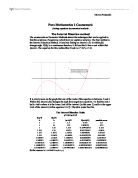As the spreadsheet (Appendix 2) shown Newton-Raphson method is most efficient method to find a root. ( It just required 4 steps to find the root.)
Formula Application
The sequence of values generated by
Xr+1 = Xr – f (Xr)/ f’ (Xr), X0 is given. This will usually converge to a root of f (x) = 0 near to x = x0. The method is called the Newton-Raphson method and has second order convergence. (Appendix 5)
In my course work, the equation is (x+1) sin (1/x) = 0.
So differentiate this function by using chain rule, product rule, and trig. Differentiation.
Y =F (x) = (x+1) sin (1/x))
Y= u * v
U’ = 1
V’ = -(1/x^2)* cos. (1/x) (Chain rule and Trig. Differentiation)
F ‘(x) = u v’ + v u’ (Product Rule)
= Sin (1/x) – (x+1)/x^2* cos. (1/x)
Then I put the function f (x) = (x+1) sin (1/x) into the graphic calculator, using the table to store the information with the range 0.05 as starting point, 1 as the end point, 0.01 as the pitch. I use the calculator to see how many roots are there roughly. The calculator lists a table and draws a graph for me. (Appendix 3 and 4)
From the table and graph, we can see that there may be 6 roots in the interval (0.05, 1). There are between 0.05 and 0.06, 0.06 and 0.07, etc. Then I use the same method to check whether or not there is exactly only 1 root in the interval. Instead, I use 0.05 as starting value, 0.06 as end value, and 0.001 as pitch. The table is shown on the other page.
So there is exactly 1 root in the interval (0.05, 0.06), Then check next possible interval (0.06, 0.07). The reason why there are not any roots in the interval (0.32, 1) is as the x value become bigger, y (y >0) value become bigger as well, so the graph y = (x+1) sin (1/x) can not interrupt the x axis any more.
Then I take the bottom interval value as my start value 0.051 for the N.R. method in the spreadsheet to find the approximation value of the roots. (Appendix 5)
Error Analysis
From the spreadsheet, I can see that there is an error, which is, I want to find a root near to 0.712, but the Newton-Raphson method lead the approximation to the convergence at 0.039788736. I check my equation and find no mistakes, so I decide to check it in more detail. I start the value from 0.06 to 0.076 and then calculate the f (x) value, draw a graph (Appendix 6). From the graph I can see if I want to draw a tangent to the point (0.0712, 1.067). The tangent will interrupt the x-axis, and the new approximation value is further away from the root 0.079, and it go to another root 0.039788736. So, if I want to find the root 0.07, I must find a value between the turning point and root. So I check to start at 0.073 to get the root 0.079577472. I also tired other starting value to see if N.R. converged more quickly. My conclusion is if I choose the start value is closer to the root I want to find, N.R. can go to the convergence more quickly.
Another problem is in the theory, the Newton-Raphson method is in order 2, but in the case which I want to find the root 0.0513 the ratio En/ En-1^2 doesn’t go to convergence. That because of the ill condition problem, a very small value divides by another very small value, the result will be very big, which can be shown in (Appendix 5, Col G, Row 15 to 19).
Successive error = Xn – Xn-1 Which in the spreadsheet (Appendix 5,Col H) is for example: H14=B15-B14; From the spreadsheet I can see that the successive errors become smaller then equal to 0, the patterns don’t change any more.
And from the spreadsheet (Appendix 5, Col G), after a few steps the ratio En/ En-1 approaches 0. However, if I examine the ratio En/ En-1^2 I find that after a couple of steps this ratio become a constant, so En=kEn-1^2 where k is a constant. Looking at other example solved shows that this is normally the case. And I can say that Newton- Raphson method is of second order, which will mean each application of the Newton- Raphson formula approximately doubles the number of correct decimal places in the approximation. Hence if X0 is correct to 1 decimal place, X1 will probably be correct to 2 decimal places, X2 to 4 decimal places, and so on.
Because Ms Excel spreadsheet just can go to the accuracy as far as 9 decimal places, so my solution just can achieve 8 decimal places, because of rounding in the computer program
Interpretation
The roots of the equation (x+1) sin (1/x) =0 are
* 0.053051648,
* 0.063661977,
* 0.106103295,
* 0.159154943,
* 0.318309886,
* 0.079577472. (8 decimal places).
Because the Successive errors of all the roots become smaller and turn to 0 at the end, and the En/ En-1^2 ratio becomes constant, I can say my solution is valid.
So the limitation of Newton-Raphson method is I need to choose the roots very carefully otherwise I can’t find the roots I want to find. Particularly to find roots at 0.0795774472, it is very important to choose the correct value.
And the disadvantage of Secant method is that, like the Newton-Raphson method, can lead to divergence in some cases. (Appendix 7)
And for the fix-iteration, this method seem not so good to the equation (x+1)sin (1/X) =0
The bisection method is good, reliable method for solving an equation f (x) = 0, it always go to the convergence but it reduces the rate of going to convergence, because it halves the interval width.







